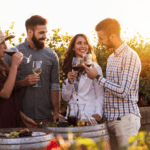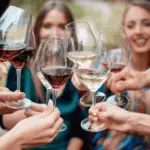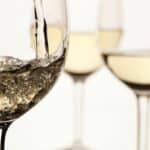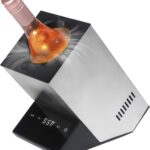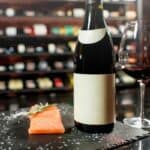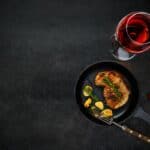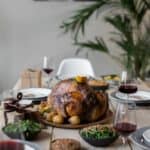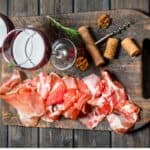Learning to taste wine is an exciting journey that opens up a world of flavors and sensations. As we explore wine tasting, we become more attuned to the delicate variances in wine characteristics and learn how to savor each sip. It’s a skill that enhances not only our palate but also our social experiences, whether we’re enjoying a quiet evening at home or attending a bustling wine tasting event. For beginners, the process starts with understanding the fundamental aspects of wine, from varietals to vineyards, and the basic approaches to tasting.

Advancing in wine tasting involves a sensory exploration where we engage our sense of smell and taste to analyze the complexities within each glass. This sensory journey is not just about sipping; it’s about recognizing the notes and textures that give each wine its unique profile. Building confidence in wine tasting comes with practice, and over time, we develop our tasting notes, which guide us in identifying different wines and understanding our preferences. Knowledge of wine pairings and the impact of food on taste further enriches our experience.
Key Takeaways
- Understanding wine basics enhances enjoyment and ability to taste.
- Sensory exploration and analysis are vital for recognizing wine characteristics.
- Regular practice leads to building confidence and personal wine knowledge.
Understanding the Basics
Embarking on the journey of wine tasting allows us to explore a spectrum of flavors and aromas. By understanding a few fundamental concepts, we lay the groundwork for an enriching experience that deepens our appreciation for this timeless beverage.
Wine 101
Wine is an intricate beverage that one can appreciate on numerous levels. Our exploration begins with acknowledging the major types of wine: red wine and white wine. Red wines often exude bold flavors with varying levels of tannin, which contributes to their structure and is associated with a dry sensation in the mouth. White wines, on the other hand, may showcase brighter acidity, contributing to their crisp, refreshing quality.
Wine attributes include sweetness, acidity, tannin, alcohol, and body. A palate that recognizes these elements can determine the balance of a wine: how the flavors integrate and complement each other. Sweetness can range from dry wine, with no perceptible sugar, to desserts wines, which are distinctly sweet. Bitterness is usually a result of tannin found primarily in red wines. Acidity gives wine its tart and zesty character, while alcohol contributes to the warmth felt in the throat. The body of a wine can be light, medium, or full, and is often indicative of its heft and overall mouthfeel.
As sommeliers might advise, understanding these basics will assist us in pairing wine effectively with food to enhance both the drink and the meal.
The Importance of Glassware
Selecting the proper glassware is essential for wine tasting as it influences how we look at wine, swirl wine, and perceive its aroma. The shape of the glass can drastically impact our experience by concentrating the wine’s bouquet and directing the wine to various parts of our palate, thereby amplifying specific flavors and textures.
A quality wine glass should have a clear bowl to permit an unobstructed view of the wine’s color, clarity, and opacity. When we fill our glass and swirl it, we not only integrate air, enhancing the wine’s aroma, but we also observe the “legs” or “tears” that form, which may indicate the wine’s alcohol and sugar content. More prominent legs can suggest a higher alcohol content or more residual sugar.
A proper glass also allows us to assess the wine’s sight: its hue and intensity, which can provide clues about the wine’s identity and condition. We savor wine with our eyes first, appreciating its color and transparency before we even take the first sip. By prioritizing the right glassware, we ensure that our wine tasting is as informative as it is pleasurable.
Sensory Exploration

In wine tasting, we engage our senses to evaluate and enjoy the wine’s character and quality. Our visual perception, sense of smell, and taste buds are vital in this sensory journey.
Sight and Color
Clarity and Hue: We start our exploration by observing the wine’s clarity and color. A simple swirl in the glass can reveal the wine’s age and concentration. For instance, a deeper hue may suggest a higher level of aging or intensity.
Opacity and Wine Legs: We inspect the wine’s opacity to understand its body, and we watch the wine legs, or tears, that form on the glass after swirling to gain insight into alcohol content and sweetness.
Aroma and Bouquet
Primary Aromas: Our first impression through smell is of the primary aromas which originate from the grape variety itself, including notes of fruit, flowers, and herbs.
- Fruit Aromas: Scents of citrus, berries, or tropical fruits are common.
- Earthy Components: We may also detect earthiness that adds complexity.
Secondary Aromas: These develop during winemaking, often in oak barrels, introducing vanilla and spice nuances.
The Five Tastes
Sweetness: We detect sweetness immediately upon sipping wine, characterized by sugar levels that range from bone-dry to sweet.
Acidity: A refreshing sharpness, acidity brings life and zest to wine, often perceived on the sides of our tongue.
Tannin: The structural element in wine, tannin, provides texture and often comes across as a drying sensation in red wines.
Saltiness and Umami: Rarely pronounced, these two tastes can add depth and richness to wine, expanding its flavor profile.
Finish and Length: We assess the aftertaste, or finish, and the length, which is how long the taste lingers. This offers clues to the wine’s complexity and potential for aging.
By engaging in sensory exploration, we elevate our wine tasting experience and develop a deeper understanding and appreciation for the intricacies of each bottle.
Analyzing Flavors and Textures

When we taste wine, we evaluate the complex interplay of flavors and textures, focusing on how fruit characteristics, oak aging, tannins, acids, and the wine’s body contribute to the overall experience.
Fruit and Oak Influence
Our palate can detect a wide array of fruit flavors ranging from berry and citrus to tropical, apple, and pear notes. The presence of oak during the wine’s aging process adds layers such as vanilla and butter, enriching the flavor profile. For instance:
- Berry: Identifying whether the berry flavor leans towards ripe blackberries or tart raspberries.
- Citrus/Tropical: Noting if the citrus is more like zesty lemon or if tropical flavors like mango come to the forefront.
- Oak: Discerning subtle oak influences, including vanilla notes or a hint of butter.
The Effect of Tannins and Acids
Tannins and acids shape the wine’s structure and feel in our mouth. Here’s how we can analyze them:
- Tannins: They contribute to the astringency and are often perceived as a drying sensation in the mouth. Their quality can range from soft to robust.
- Acidity: It imparts freshness and can manifest as a sour or crisp taste that often enhances the wine’s fruitiness.
We should always seek balance between these elements so that no single aspect overpowers the others.
Describing Body and Texture
Body and texture are pivotal in our overall impression of a wine. They can be described as follows:
- Body: This refers to the weight and fullness of the wine on our palate. Wines can be light, medium, or full-bodied.
- Texture: This encompasses the tactile sensations such as creaminess, silkiness, or the presence of fizz.
A well-balanced wine harmonizes the fruit notes with oak nuances, tannins, and acid, achieving a pleasant mouthfeel and a satisfying aftertaste.
Wine Characteristics and Varieties

Understanding wine characteristics and varieties is vital to appreciating the complexity and diversity of wines. We will explore the significance of grape varieties and the influence of terroir and climate on them.
Identifying Grape Varieties
The grape variety is the type of grape used and is fundamental to a wine’s taste profile and personality. Each variety imparts unique fruit flavors and aromas, influenced by vintage and aging processes. For example, Pinot Noir, known for its delicate and aromatic qualities, typically presents red fruit flavors like cherry and raspberry. In contrast, Cabernet Sauvignon is recognized for its boldness and often yields notes of blackcurrant and tobacco.
Riesling grapes produce wines with a balance of sweetness and acidity, often tasting of green apple and lime. On the other hand, Grenache is appreciated for its berry flavors and spice, whereas Nebbiolo grapes, hailing from the Piedmont region, are associated with distinctive tar and rose flavors.
We observe Syrah to exhibit dark fruit flavors, such as blueberry and plum, often paired with earthy undertones. Similarly, Zinfandel often carries a zesty spice alongside its jammy fruitiness. Sparkling wine, made from a variety of grapes, gets its effervescence from a secondary fermentation process and can range from the brioche-like richness of a vintage Champagne to the bright and fruity notes of a Prosecco.
Terroir and Climate Influence
Terroir refers to the environment in which a wine is produced, including the soil, topography, and climate. Climate has a dramatic impact on the qualities of a grape variety, influencing aspects such as sugar content, acidity, and flavor compounds.
For instance, a Pinot Noir from the cooler climate of Burgundy may present higher acidity and more subtle fruit compared to one from the warmer climate of California, where increased sunshine can result in riper fruit flavors and fuller body. Cabernet Sauvignon thrives in a range of climates but develops different character traits; cooler regions might yield more structured wines with higher tannin content, while warmer areas generally produce wines with riper fruit and softer tannins.
Let’s consider Riesling, a grape that expresses itself differently depending on the climate: cooler regions highlight its crisp acidity and fresh fruit flavors, whereas in warmer regions, it can develop more pronounced stone fruit characteristics and richness.
Winemakers play a critical role in expressing terroir, making decisions that reflect the grape variety’s interaction with the land and climate to craft a wine that showcases its distinctive profile. The vintage, reflecting the specific year’s climatic conditions, also affects these characteristics and can greatly influence a wine’s aging potential and taste evolution over time.
The Wine Tasting Process

Wine tasting is an art that marries the rigor of methodical practice with the joy of social experiences. We’ll explore how to serve, taste, and document our wine-tasting journey.
Proper Wine Serving
Temperature: We ensure our wine is served at the ideal temperature—reds between 62-68°F and whites between 49-55°F. Proper temperature enhances the wine’s complexities and aromatic profile.
Decanting: Our red wines benefit from decanting, which allows them to breathe and release their full flavor potential.
Glassware: We opt for clear, stemmed glasses to appreciate the wine’s true color and avoid transferring body heat to the wine.
How to Swirl and Sip
How to Swirl Wine: We hold our glass by the stem and gently swirl the wine. This method aerates the wine, releasing its aromas.
Sipping Technique: We take a small sip, let it roll over our tongues, and then subtly inhale through our mouths. This allows us to discern the wine’s structure, acidity, and balance.
Tasting Notes and Journaling
Recording Our Impressions: As we taste, we jot down our impressions of the wine’s appearance, aromas, flavors, body, and finish.
Tasting Notes Format:
| Aspect | Description |
|---|---|
| Visual | Color and clarity. |
| Aroma | Scents detected. |
| Taste | Flavors experienced. |
| Texture | Mouthfeel. |
| Finish | Aftertaste. |
Journaling Purpose: Consistent record-keeping sharpens our palate and provides a reference for our future wine encounters.
Advanced Topics in Wine Tasting
In the journey to becoming adept at wine tasting, we must explore the nuances of recognizing wine faults and the complexities involved in wine aging and storage.
Understanding Wine Faults
Wine faults can greatly affect the depth of flavor in a wine, with even minor flaws creating noticeable differences in the taste profile. For example, a ‘corked’ wine, tainted by TCA (2,4,6-trichloroanisole), marginally taints the fruit flavors with an unpleasant damp, musty aroma. On the other hand, the development of volatile acidity, characterized by an overly sharp, vinegar-like scent, indicates the wine has undergone an undesirable transformation.
- Corked: A musty, wet cardboard scent signifies a cork issue.
- Volatile Acidity: Sharp, vinegar-like aromas indicate an acidic imbalance.
Recognizing these faults is essential for any seasoned wine taster, as they speak volumes about a wine’s integrity and quality.
Wine Aging and Storage
Aging wine is an intricate process that relies on time and optimal conditions to foster wine evolution and bring out a deeper complexity of flavor. Proper storage is the backbone of successful aging, with controlled temperature and humidity being key to maintaining a wine’s vitality and enabling beneficial processes like malolactic fermentation, which softens acidity and adds creamy textures to certain wines.
Aging Wine:
- Depth of Flavor: A wine’s flavor can gain richness and subtlety over time.
- Malolactic Fermentation: This process can occur during aging, altering mouthfeel and flavor profile.
Cellaring:
- Temperature: ~55°F (13°C) is considered ideal for storage.
- Humidity: 70% is the sweet spot for maintaining cork integrity and preventing oxidation.
A well-aged wine typically has less sediment, as particles precipitate out over time, making the wine appear clearer and more brilliant when served. Our appreciation for finely aged wines grows as we become familiar with the grace with which certain wines evolve, acquiring a harmony that can only be achieved through the passage of time and correct storage conditions.
Food and Wine Pairing
When we engage in the art of pairing food with wine, our aim is to elevate the dining experience by matching flavors that complement each other. We often consider the texture and flavor profile of both the wine and the dish to achieve harmony on the palate.
- Cheeses: They are a classic accompaniment for wine. A simple rule we follow is “like with like”. Creamy cheeses like brie pair well with buttery Chardonnay, while sharp cheddar complements the structured tannins of Cabernet Sauvignon.
| Cheese Type | Wine Pairing |
|---|---|
| Soft Cheese | Light-bodied whites |
| Hard Cheese | Full-bodied reds |
Bread: Often served as a palate cleanser, bread can also be a part of the pairing. We choose wines with high acidity to cut through the bread’s density, such as a crisp Sauvignon Blanc.
Food Pairing: Here we look at the main elements of the dish. For protein-rich foods, tannic reds like a Merlot work well because the fat in the food softens the astringency of the tannins. With seafood, we opt for light-bodied whites like Pinot Grigio or a mineral-driven Chardonnay.
We use the following table to guide our food pairings:
| Food Type | Wine Pairing |
|---|---|
| Red Meat | Bold red wines |
| White Meat | Light to medium reds |
| Fish | Light-bodied whites |
| Vegetarian | Versatile whites |
Understanding the balance between the weight of both the wine and the food, we ensure that neither overpowers the other. The acidity, sweetness, or umami of a dish can be either contrasted or complemented depending on the wine selected. Ultimately, our goal is a seamless integration of flavors that delights the senses.
Building Wine Confidence
When we approach wine tasting, it’s natural for us to feel a bit out of our depth. However, building confidence in this art is a journey we can all enjoy. Here’s how we can become more comfortable and knowledgeable about wine.
Start Simple: Begin with well-known wines and identify basic flavors.
Expand Slowly: Introduce one new variety at a time, comparing and contrasting it with what we know.
We should be patient with ourselves as it takes time to foster an understanding of wine’s complex flavors. A structured approach can help us build our confidence gradually:
| Step | Action |
|---|---|
| Educate Ourselves | We can read books, watch documentaries, and attend seminars to absorb knowledge about the different wine regions, grapes, and the winemaking process. |
| Tasting Practice | We should regularly practice tasting, keeping notes on aroma, body, taste, and aftertaste. |
| Share Experiences | Discussing wine with others can reinforce our learning and boost our confidence. |
By sticking with these practices, we become less intimidated by the wide world of wines. The key is to remain open-minded and curious, not shying away from asking questions, no matter how elementary they may seem. The more we learn, the more confidence we gain, and soon, we’ll be navigating wine like a pro without feeling overwhelmed. Remember, every expert was once a beginner, and they achieved mastery through consistent, incremental steps. Let’s embrace this exciting learning curve together.
Exploring Wine Resources
In our journey to learn wine tasting, we’ve discovered a wealth of resources that greatly aid in enhancing our understanding and appreciation of wine. It’s essential we tap into various platforms to broaden our horizons.
Books are fundamental tools for learning in-depth about wine. One such indispensable resource is “Wine Folly” by Madeline Puckette and Justin Hammack. It’s a visual guide that breaks down complex wine concepts into easy-to-understand graphics and explanations.
Online resources offer a dynamic way to learn about wine tasting. Websites like VinePair provide us with articles, infographics, and interactive content tailored for both beginners and connoisseurs. These platforms cater to our thirst for knowledge with updated and relevant insights into the world of wine.
| Resource Type | Examples |
|---|---|
| Books | Wine Folly: The Essential Guide to Wine |
| Websites | VinePair, Wine Folly |
We consult sommeliers not only for their expertise in wine selection but also for their knowledge in the art of tasting. They are a practical source of knowledge, often sharing their experiences and suggesting resources that align with our level of expertise and interest.
When we prioritize authentic wine resources, we ensure that our learning is built on a foundation of credibility and expertise. Leveraging these resources optimally leads us to a deeper understanding and a more profound enjoyment of wine tasting.
Frequently Asked Questions
In this section, we’ll address common inquiries about the nuances of wine tasting, equipping you with the knowledge needed to enhance your experience.
What are the steps involved in professionally tasting wine?
We begin by observing the wine’s color and clarity. Next, we swirl the wine to release aromas and take a deep sniff to assess its bouquet. Then we taste, noting flavors, acidity, tannins, and aftertaste, often spitting it out to stay clear-headed.
What should I look for when performing a wine tasting in a restaurant setting?
We consider the wine’s compatibility with our meal and observe serving temperature and glassware, which can impact the tasting experience. We taste a small amount to confirm the wine’s quality and characteristics before approving the bottle.
What terminology is essential to understand when tasting and describing wine?
Familiarize ourselves with terms like body, bouquet, finish, and legs. These help us articulate our experience and communicate about the subtleties and complexities of the wine.
How can I develop my wine tasting palate as a beginner?
We start by tasting a variety of wines to explore different flavors and styles. Keeping a tasting journal can help us track our impressions and identify preferences, guiding our palate development.
What basic knowledge should a server possess to confidently recommend and serve wine?
Servers should understand wine basics, including major types, popular regions, and pairing principles. Proper serving protocol, such as the correct order and temperature, is also paramount in confidently assisting guests.
How does one identify the four basic elements during wine tasting?
We focus on sweetness, acidity, tannins, and alcohol. Sweetness is detected at the tip of the tongue, while acidity creates a mouthwatering sensation. Tannins feel astringent or drying, and alcohol is perceived through the wine’s body and warmth.
- How to Learn Wine Tasting: Essentials for Beginners - March 10, 2024
- How to Learn to Like Wine: Cultivating an Appreciation for the Vintner’s Art - March 10, 2024
- Thanksgiving Sangria: A Flavorful Twist to Your Holiday Table - August 27, 2023

